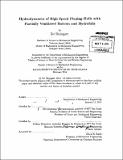| dc.contributor.advisor | Chryssostomos Chryssostomidis. | en_US |
| dc.contributor.author | Sheingart, Zvi | en_US |
| dc.contributor.other | Massachusetts Institute of Technology. Department of Mechanical Engineering. | en_US |
| dc.date.accessioned | 2014-06-13T22:37:48Z | |
| dc.date.available | 2014-06-13T22:37:48Z | |
| dc.date.copyright | 2014 | en_US |
| dc.date.issued | 2014 | en_US |
| dc.identifier.uri | http://hdl.handle.net/1721.1/87968 | |
| dc.description | Thesis: S.M., Massachusetts Institute of Technology, Department of Mechanical Engineering, 2014. | en_US |
| dc.description | Thesis: S.M. in Naval Architecture and Marine Engineering, Massachusetts Institute of Technology, Department of Mechanical Engineering, 2014. | en_US |
| dc.description | Cataloged from PDF version of thesis. | en_US |
| dc.description | Includes bibliographical references (pages 88-90). | en_US |
| dc.description.abstract | The influence of a cambered shaped bottom step on the performance of sea going V-stepped planing hulls is investigated using numerical methods. The shape of the step was designed to decrease the Drag/Lift ratio of the hull in full planing regime (Fr[delta sign turned upside down] = 6 ). A numerical method, complementary to the existing empirical method developed by Clement for design of a cambered step has been developed. The numerical approach described in this thesis extends the empirical Clement's method for stepped hull design to hard chine hulls with higher deadrise. The stem trim stabilizer has been replaced by supercavitating hydrofoils. Several foil/step configurations were numerically tested. RANSE code is used to evaluate the performance of new hull design with a stepped bottom. Prototypes of the hull have been modeled in 3D using Rhino, NURBS surface modeler. Two validation cases have been considered to validate the RANSE models used for the numerical prediction of hydrodynamic characteristics: Geritsma's 25° deadrise hull series and original Clement's 12.5° deadrise hull (DTMB Model 5115). Numerical results showed good agreement with experimental data, except for the pre-planing regime, where an influence of the towing rig on the CG rise was not negligible. The baseline for the design of the hybrid stepped hull chosen to be Geritsma's 25° hull with length to maximum beam ratio of 4.09. The thesis confirms the applicability of Clement's method on deep-V seagoing hulls. Total reduction of 3% in Drag/Lift ratio has been achieved, but can be further reduced. All the RANSE calculations were performed using Star-CCM+® software package on the 400 cores HPC cluster of MIT i-Ship lab. | en_US |
| dc.description.statementofresponsibility | by Zvi Sheingart. | en_US |
| dc.format.extent | 94 pages | en_US |
| dc.language.iso | eng | en_US |
| dc.publisher | Massachusetts Institute of Technology | en_US |
| dc.rights | M.I.T. theses are protected by copyright. They may be viewed from this source for any purpose, but reproduction or distribution in any format is prohibited without written permission. See provided URL for inquiries about permission. | en_US |
| dc.rights.uri | http://dspace.mit.edu/handle/1721.1/7582 | en_US |
| dc.subject | Mechanical Engineering. | en_US |
| dc.title | Hydrodynamics of high speed planing hulls with partially ventilated bottom and hydrofoils | en_US |
| dc.type | Thesis | en_US |
| dc.description.degree | S.M. | en_US |
| dc.description.degree | S.M. in Naval Architecture and Marine Engineering | en_US |
| dc.contributor.department | Massachusetts Institute of Technology. Department of Mechanical Engineering | |
| dc.identifier.oclc | 880689154 | en_US |
